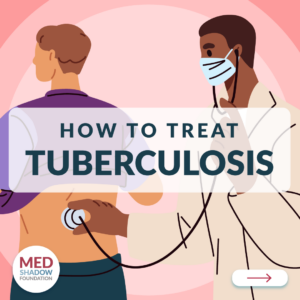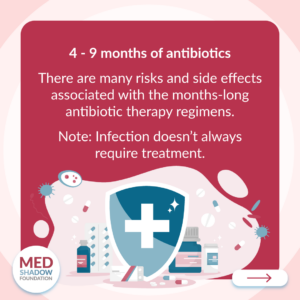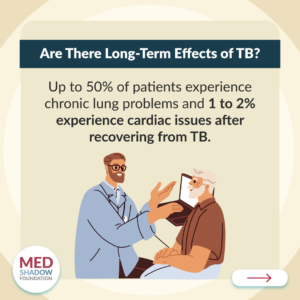Tuberculosis (TB) can be a severe, debilitating, and even fatal disease. Treatment, which sometimes requires hospitalization, can take months. Still, some experts point out that the infection doesn’t always require treatment. Here’s what you need to know about antibiotics for TB and the side effects of TB treatments.
What is Tuberculosis?
TB is a bacterial disease that usually attacks your lungs, though it can also infiltrate other organs such as your kidneys and brain. Getting infected with the bacteria can cause two different types of infections. The first, is “active TB disease” which causes symptoms such as:
- Cough with phlegm and sometimes blood (often lasting three weeks or longer)
- Chest pains
- Fever
- Chills
- Weight loss
The other is a “latent TB infection” that doesn’t cause any symptoms but can eventually turn into TB disease. While you won’t have symptoms, you will still test positive for the disease. There is a movement to identify more subcategories of disease that could impact treatment regimens in the future, but for now, most providers recognize just active and latent TB. If you’ve been exposed, ask your healthcare provider as soon as possible if you should get tested.
It’s important to know that TB kills about 1.5 million people every year. Having been infected with the bacteria is not a guarantee that you will eventually develop TB disease. In fact, while it was once thought that if you were infected, you had latent TB for life, researchers now believe that many people’s immune systems clear the virus on their own, without ever causing the disease. You are most likely to become sick within the first two years of contracting the bacteria.
The risk of developing TB disease is higher for infants and children than it is for adolescents and adults. Below is the likelihood that children with the infection will develop the disease within two years based on their age.
- Infants (≤1 year): 50%
- Ages 1 to 2 years: 12 to 25%
- Ages 2-5 years: 5%
- Ages 5-10 years: 2%
- Age >10 years: 1 to 2%
Tuberculosis (TB) Statistics
Can Tuberculosis be Cured?
With the proper antibiotic treatment, TB disease can typically be cured in four to nine months.
How is Tuberculosis Transmitted?
Typically, tuberculosis can only be transmitted from one person to another while the first person has an active infection. Infected individuals can spread the bacteria in droplets that escape the body when they cough, speak, or breathe. You can get infected when you inhale those droplets.
If you have TB disease, it’s ideal to quarantine to the best of your ability until your healthcare provider says it’s safe to go out (usually a few weeks after starting treatment), to avoid spreading the disease. If you have been infected with TB, but don’t have TB disease, you won’t spread it to other people.
Infographic Maps of How Many Tuberculosis Cases Are in the US, Canada, and Worldwide
How many cases of TB in the US?
How Many Cases of TB in Canada?
How Many Cases of TB in the World?
Do They Still Vaccinate Against TB?
There is a vaccine to prevent TB, called the Bacille Calmette-Guérin (BCG) vaccine, but it’s rarely used in the United States today. It’s most effective for younger children and protection seems to wane over time. Thus, it is sometimes given to those in high-risk regions or who are being continually exposed, because they have a parent with the disease, for example. The CDC doesn’t recommend the vaccine for most people, even if you’re traveling overseas. Instead, the organization suggests keeping your distance from people who are known to be infected or are showing symptoms, and wearing N95 masks in crowded environments where you might run into people with the disease, such as hospitals.
Tuberculosis Treatment

Healthcare providers may prescribe antibiotics to treat both TB disease and TB infection without symptoms. Only those who would benefit from treatment should be tested. There are many risks and side effects associated with the months-long antibiotic therapy regimens, so if you have tested positive but don’t have symptoms, and you’re not at high risk of developing TB disease, your provider might not recommend treatment.
Who Needs TB Treatment?
For many years, researchers said that once you’re infected with TB bacteria, you’ll always be at risk of the disease emerging, but in recent years, they’ve started to acknowledge that many people who are infected never end up having or spreading disease.
While we may test positive for the disease, the tests often react to antibodies you formed in fighting off the disease. These antibodies can stay in your body even if you’ve completely cleared the infection. Unfortunately, it’s not always easy to tell who has cleared the infection and who hasn’t, which is why many people may still be receiving treatments they don’t need.
Antibiotics for TB Disease
If you have active TB disease, your healthcare provider will likely recommend one of three treatment regimens. The regimens require taking several different antibiotics for four, six or nine months. Typically, your provider will recommend the regimen with the shortest duration (four months), but there are many reasons he or she might suggest another regimen.
The antibiotics in one treatment plan, for example, might interfere with other medications you’re taking for chronic conditions, or you may have a bacterial strain that is resistant to a shorter regimen.
Four-Month TB Disease Treatment

The four-month regimen includes four different antibiotics: high-dose daily rifapentine (RPT), moxifloxacin (MOX) (a fluoroquinolone), isoniazid (INH), and pyrazinamide (PZA). For the first eight weeks, you take all four medications (RPT, MOX, INH and PZA). During the next nine weeks, you only take RPT, MOX, and INH.
Six- to Nine-Month TB Disease Treatment
There are four different dosing regimens that last from six to nine months. The first eight weeks all include four medications: Rifampin (RIF), INH, PZA, and Ethambutol (EMB). Then you continue with RIF and INH for the remainder of the treatment.
Three-, Four-, Six-, or Nine-Month Treatment for TB Infection
If you don’t have active TB disease, but your healthcare provider recommends treating your infection, there are several regimens that include combinations of INH, RPT, and rifampin (RIF).
Side Effects of Treatment for Tuberculosis Disease and Infection
Prior to starting your medication, you’ll need some baseline blood tests. Your healthcare provider may check your liver and kidney function and test for human immunodeficiency virus (HIV) or hepatitis infections. Throughout treatment, you should be in contact with your physician regularly.
If you experience any of the following symptoms, you should report them immediately; they can suggest that your liver is getting damaged.
- Lack of appetite
- Nausea
- Vomiting
- Dark urine
- Yellowing of the eyes and skin
- Rash
- Fatigue
- Fever
- Easy bruising or bleeding
- Joint pain
Side Effects of Rifapentine (RPT)
- Rash or itchiness
- Flu-like symptoms
Side Effects of Moxifloxacin (MOX)
- Liver damage, but this side effect is more common with INH and PZA than it is with MOX
- Rash or itchiness
- Skin sensitivity to sunlight
- Increased risk of fungal infections of the skin and nails
- Irregular heart beats
- Psychosis
- Seizures
- Tendonitis and tendon rupture
- Joint and muscle pain
- A metallic taste in the mouth
Several patients on AskaPatient.com were prescribed MOX for conditions other than TB, and described feeling serious anxiety, depression, and suicidal thoughts, along with nerve and joint pain.
Fluoroquinoline drugs, such as MOX, are known to carry the risk of psychiatric side effects and suicidal ideation. A 31-year-old woman who was prescribed the drug for pneumonia wrote about her experience.
“Day 1 nothing other than foggy memory. Day 2 auditory and visual hallucinations, vision changes, panic attack, tingling head, foggy memory, dry mouth,” she writes. “Day 3 I split the tablet to space out the effects, [but] effects still appeared (racing thoughts, mood changes, panic, suicidal thoughts that were not my own), sore knee joints, joints cracking and popping. I have never had suicidal thoughts prior to this.”
Side Effects of Isoniazid (INH)
- Liver damage
- Rash or itchiness
- Hives
- Temporary hair loss
- Nerve damage
- Depression and suicidal ideation
- Seizures
- Changes in the counts of red and white blood cells (blood counts)
- Changes in your vision due to optic nerve damage
- Joint and muscle pain
- Flu-like symptoms
Side Effects of Pyrazinamide (PZA)
- Liver damage
- Rash or itchiness
- Flushing/redness of the face lasting two to three hours after you take the drug
- Hives
- Skin sensitivity to sunlight
- Joint and muscle pain
Side Effects of Ethambutol (EMB)
- Rash or itchiness
- Hives
- Depression and suicidal ideation
- Changes in your vision due to optic nerve damage
Side Effects of Rifampin (RIF)
- Liver damage
- Hives
- Flushing/redness
- Changes in the counts of red and white blood cells (blood counts)
- Flu-like symptoms
What You Can Do About Side Effects of Tuberculosis Medicines:
As with many antibiotics, gastrointestinal side effects are common. In some cases, you may be able to reduce your discomfort if you take your dose with a snack, or avoid medications such as non-steroidal anti inflammatory drugs (NSAIDs) which can also hurt your stomach, while taking your course. In other cases, your provider may adjust your dosing or switch you to a different regimen.
If you experience vomiting or diarrhea, it’s important to stay hydrated. Sophia told the World Health Organization that she would vomit every time she took a pill, until her healthcare providers started giving them to her with porridge, which made it easier for her to keep the antibiotics down.
You should be monitored at least monthly for liver function.
If you are taking EMB, your provider will also test your vision regularly. Be on the lookout for difficulty differentiating between red and green.
If you’re taking MOX, your doctor will conduct regular electrocardiograms to monitor your heart’s rhythm.
If you have a mild rash or itchiness, you can take antihistamines and it should clear up within a few weeks, even as you continue taking the medication, but you should still report it to your provider anyway.
If you have changes in your complete blood count (CBC), your physician may recommend that you pause your medication until those counts recover.
Can I Drink Alcohol While Taking Antibiotics?
There’s conflicting information about whether or not it’s safe to drink while using antibiotics. One study showed that different pharmacies even put different warnings on different antibiotics. For example, Rite Aid had a label telling people taking MOX to limit alcoholic beverages whereas Walgreen’s and CVS didn’t have a warning related to alcohol on the drug.
Taking antibiotics for an extended period of time, like you will have to while treating TB, can stress your liver. Alcohol might exacerbate this risk, so to be safe, it’s ideal to limit your drinking. If you have an alcohol use disorder, it’s crucial that you let your doctor know as that may affect your treatment plan.
Drug-Resistant TB
The antibiotic regimens described above are the first-line treatments for TB. There are strains of TB, however, that don’t respond to these antibiotics. If you have one of these strains of TB, you may need other antibiotic medications and longer treatment plans to kill the bacteria.
Ingrid, who had a drug resistant form of TB told the World Health Organization it took two years of antibiotic treatments to cure her disease. After 75 days in the hospital, during which she had liver failure and almost died, she was weak and said she “was struggling to cope with the injection and the pills that caused diarrhea and vomiting.” Soon though, she started to feel better and was able to gradually start exercising and gaining her energy back.
What Are the Long-Term Effects of TB?

Researchers say we need a lot more information on the long-term effects of TB, but so far, we know that many patients develop chronic lung disease. If the bacteria reached your heart or central nervous system, it could cause ongoing inflammation in your heart and movement problems. The estimates are preliminary but scientists say up to 20 to 50% of patients experience chronic lung problems and 1 to 2% experience cardiac issues after recovering from TB.
Other patients mention that the side effects of TB medications can cause symptoms that last even after you stop taking them. One 24-year-old TB survivor told researchers his experience.
“Unfortunately, many individuals, like myself, suffer for years after treatment completion to battle against side effects of the medication,” says the patient in the study. “The toxicity of the medication is overlooked, and more care should be given to post-TB health and the well-being of every TB survivor.”
What Happens After TB Treatment?
As you go through treatment, you’ll need to be retested each month until your results are negative two months in a row. You should also tell your healthcare provider if you’re feeling any lingering symptoms or side effects of the medications such as difficulty exercising.
How Can I Strengthen My Lungs After TB?
Treatment for TB is long, and it makes sense that you might lose some of your fitness, strength, and endurance during it, but if you’re constantly coughing or feeling out of breath with very little exertion, you may need additional treatment to regain your strength. Your healthcare provider will look for fungal and bacterial infections that may have snuck in while your body was busy fighting TB, or inflammation that didn’t get the message that it’s time to stop fighting the disease and is instead starting to damage your healthy tissues. If one of these seems to be the cause of your symptoms, your physician may prescribe antifungals, additional antibiotics, or steroids to dampen inflammation.
However, even without excess inflammation or additional pathogens, TB can leave your lungs weak and damaged. There isn’t a lot of research on how people can strengthen their lungs after TB specifically, but there is preliminary evidence that pulmonary rehabilitation, programs that help people manage chronic lung disease and increase strength and endurance, can help. Plus, the techniques have been studied in other chronic lung diseases such as COPD (chronic obstructive pulmonary disease) for which they have provided substantial relief to patients, including by reducing anxiety and depression.
Ask your doctor to refer you to someone who can help you get started with pulmonary rehabilitation after you’ve recovered. A specialist can teach you breathing exercises such as diaphragmatic breathing, in which you practice engaging your diaphragm to expand and fill your lungs as you breathe, to help you practice getting enough oxygen when you’re having trouble breathing. They’ll help you gradually start incorporating exercises like walking and resistance training (such as weightlifting or yoga) while paying close attention to your oxygen levels and how you’re breathing.
To get started on your own, check out these two breathing exercises described by the American Lung Association.
How Long After Being Exposed to TB Will I Test Positive?
If the first test is negative, close contacts of patients with pulmonary TB disease should undergo a second test 8 to 10 weeks later.
Skin Test
The most common TB test is a skin test. A healthcare professional will inject a small amount of fluid into your arm. If the test detects TB antibodies, the area of the injection will swell over the next 48 to 72 hours, much like a mosquito bite. If you test negative, it’s unlikely that you are infected with TB bacteria. Anyone who is currently infected, has previously been infected with TB, or who has received a vaccine against TB will test positive forever.
Blood Tests
Because skin tests require you to visit the healthcare provider twice (once to receive the infection then again to review your reaction to it), some providers recommend a blood test, which only requires one visit. Like the skin test, a positive result only confirms that you were exposed to the bacteria at some point, so you’ll need more testing to determine whether or not you’re currently infected with TB.
If you test positive on either test, your healthcare provider will conduct a physical exam and may order X-rays and other blood tests to determine whether or not you have an active infection and require treatment.
Who Is at Higher Risk of TB?
Children and adolescents are more likely to get TB disease if they are infected with the bacteria than adults are, especially if they are under the age of 4.
People with HIV or diabetes are also known to be more likely to experience TB disease and for the disease to spread to other parts of the body such as the central nervous system.
While most people with TB infections either clear the infection or develop TB disease within two years, the bacteria can persist longer in some individuals. In these cases, you may get TB disease at a later date when your immune system is weakened. For example, you may be more susceptible like Ingrid. Ingrid’s symptoms started when she was prescribed immunosuppressant drugs for her ulcerative colitis.





